RELIGIOUS TOURISM - PROPOSALS AND PERSPECTIVES
Manola Maria
Associate Professor, University of West Attica, Department of Tourism Management,Athens, Greece
Koufadakis, Stylianos
Adjunct Lecturer, University of West Attica, Department of Tourism Management,Athens, Greece.
Choutochristos Panagiotis
University of West Attica, Department of Tourism Management,Athens, Greece.
ABSTRACT
Greece as a place is famous for its tangible and intangible cultural heritage, which is a reason to visit for many of the travelers who choose it as a destination. One of the reasons to organize a visit is also religious tourism in places where there are ancient temples, Byzantine and modern churches, monasteries and wherever similar cultural events are organized. The above are elements that due to their special character possess the attributes of quality and competitiveness that make the tourism product particularly attractive, as important attractions they interest both Greek and foreign visitors. Naturally, religious tourism is also a field for research in the Department of Tourism Management.
The purpose of this study is to investigate firstly if there is interest on behalf of the students of the department to get involved in the field of religious-cultural tourism and secondly to record their views on the subject.
KEY WORDS: Cultural, Religious Tourism, student views
- Tourism and Religion
Travelers today consume more products and invest significantly more money in their trips rendering tourism as an important source of financial inflow into the local economy. The element of religion has been a very strong and integral part of culture and society since antiquity and naturally religious trips generated financial profit for the recipient areas.
According to Rodosthenous (2016) people since the ancient times used to travel for days away from their settlements with the aim of reaching a holy place to practice their worship and offer gifts to the temples in the hope that this act would provide them health and good fortune, seeking meaning and truth through religion. With the increase in income and the evolution of consumption patterns, in recent years, with the improvement of the tourism climate, there has been a significant increase in the demand for Religious Tourism. This is beneficial for modern Greece, as it is a form of tourism that can effectively help transform the tourism product into a sustainable and attractive one throughout the whole year, while it can also contribute to increasing revenues in periods of low demand, as well as improve the image of the country as a travel destination.
1.2 Greece as a religious destination
All regions of Greece should unveil their religious wealth, in order to increase tourist arrivals and generate additional income for their society and economy. The number of religious monuments per region as reported by Polyzos & Niavis (2013) does not necessarily offer significant competitive advantage as other than the numbers there are many factors that influence the choice of destination, such as the history and timeline of the monuments.
In ancient times travelers navigated to a holy place almost exclusively to worship, but today they also visit monuments to participate in events and educational tours, to get involved in charity projects, to learn about new customs, traditions and more. Religious faith used to have a decisive role in the exercise of Religious Tourism, today according to Manola & Tsatalbassoglou (2021) many are the travelers that visit them purely for reasons of spiritual and historical value.
Religious Tourism today represents a complex and developed part of the tourism industry (Tala et al, 2008).
Religious trips apart from travel agencies are often organized at the suggestion of some parishes which in order to meet the religious sentiment of the faithful, organize trips to other temples, monuments and holy places. There are also travel agencies that specialize exclusively in Religious Tourism, providing a more refined and competitive product compared to the common travel agencies (Rejman et al, 2016)
The development of this specific form of tourism at an international level attracted the interest of tourism organizations and agencies, which organized numerous conferences[1] to research and discuss the position of this type of tourism in the wider tourism market and the strategies to follow.
1.3 DEVELOPMENT FACTORS
Important factors that help to upgrade and develop the religious tourism product are the promotion of the product and the creation of a positive destination image through visual media, as well as the establishment of monuments in cultural routes (Manola & Teliopoulou, 2021).
In more detail it is noted that:
- There are many tools that a tourism business can use to achieve this goal. The most effective one is the internet, as many people use it often, when they want to plan a trip, looking for information about the destinations and tour packages they desire (Terzidou et al, 2008).
- Visual media also have an important role in forming the traveler’s destination image. They offer visual information about the condition and appearance of monuments and sacred sites, which can lead to the formation of a negative or positive opinion by the travelers before visiting them. As mentioned by Tsatalbassoglou (2020), a digital representation during the tour or an interactive virtual description from important moments of the monuments enabled tourists to visualize events and make an attractive transition to the past by multiplying their senses.
- The power of the small and big screen should not be underestimated. Numerous films and documentaries have been shot in Greece, such as “Athos”, which offers information about the sacred sites of Mount Athos and the life of the Monks, contributing to the increase of Tourism in the area (Terzidou et al, 2018).
2.1 RESEARCH
In the context of this article, a targeted research was carried out on Religious Tourism and the factors that can push its further development in Greece in order to investigate the opinions of a representative sample of students in the Tourism Management Department. The method of quantitative analysis through systematic sampling was used, which according to Babbie (2011) is appropriate for this case, as the sharing of the questionnaire was carried out by sending an academic electronic message to all students of the department attending the course “Case Study - Laboratory”. The total number of students who chose this course was 450, of which 390 were active and 317 responses were received. The questionnaire was created using Google Forms, it consisted of 15 close-ended and 2 open-ended questions. The first three questions were related to gender, age and year of study. The next four were about the characteristics of Religious Tourism and eight questions of the third part were about the students’ opinion regarding the possibility of their involvement in the field and their suggestions for improving this specific type of tourism. In the questionnaire there were also 2 open-ended questions for possible suggestions.
A. Demographic characteristics
By studying the demographic characteristics, we find out that 69,2% of the research participants are women, with only 30,8% being men. Regarding age, the majority of the sample is 21-23 years old with a percentage of 59,8%, while 25,6 and 14,5 percent respectively belong to the age group of 18-20 and 24+. Regarding to the year of study, the vast majority with 70,9% stated that they are in their 4th or higher year of studies.
B. Interest regarding Religious Tourism
The first Table showcases the answers to questions b1 and b2, in particular «How often do you take part in trips and excursions» and «How often do you visit religious temples and monuments as part of your travels».
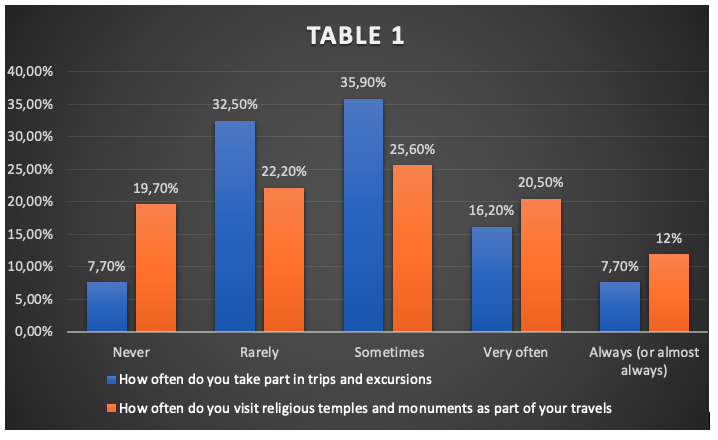
TABLE 1: Participation in trips and visits to monuments as part of the trips
As we see from the graph, respondents tend to participate in travels whenever given the opportunity, while also keeping in touch with the religious element as 58,1% state that they sometimes up to always visit religious monuments during their trips. […]
In question b3 «How do you usually travel» the answers are concentrated
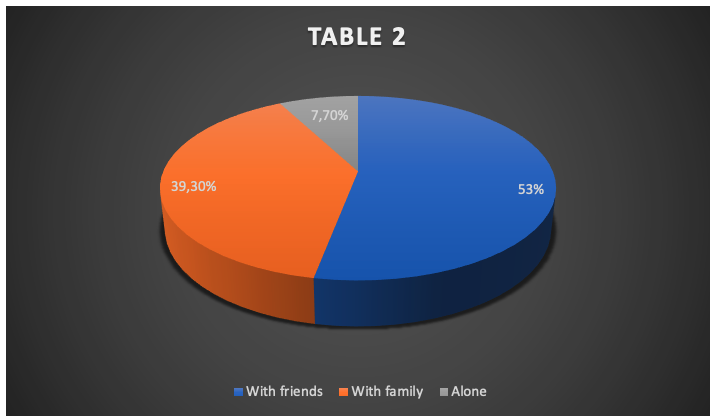
Table 2: Travelling preference
As shown in the second table, the majority of the respondents travel with friends (53%) or with their family (39,3%) while only 7,7% travel alone.
Question b4: « How often do you read historical or religious texts? »
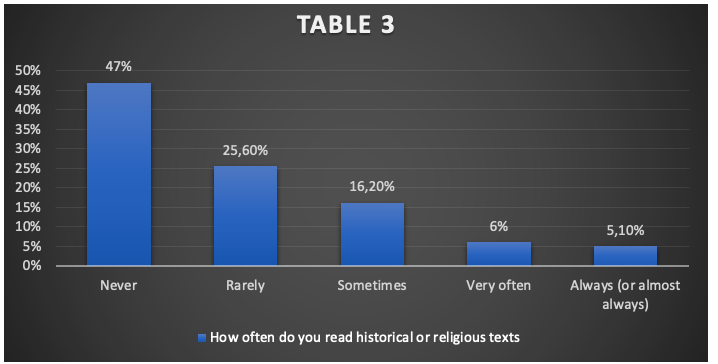
TABLE 3: Reading of historical or religious texts
The respondents answered that they do not usually read religious or historical texts, with an average score of 1.95, while 47% stated that they never read them. It seems that they prefer to use other mediums for their information such as the internet, which does not always offer the best quality of information.
C. Improvement factors – pursuit interest
In order to implement the appropriate policies and actions to continue the development of Religious Tourism, it is important to understand the main motivations for visiting religious destinations and monuments.
Question c1: « What is your main reason for visiting a monument »
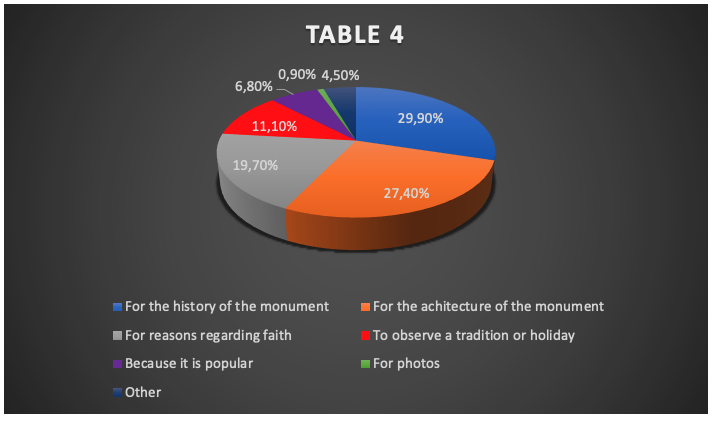
TABLE 4: The main reason for visiting a monument
As shown in Table 4, respondents were given the option to choose their main motivation for visiting monuments. The main options are six but the possibility to fill the “other” case with additional motivations which are not in the list is provided. As we can see, most students visit religious monuments for cultural reasons, with a total of 57,3% visiting them for their history or architecture, while at the same time a significant percentage of 30,8% of respondents visit them for religious reasons such as participating in religious festivals or for practicing their faith. At this point, a percentage (6,8%) should be taken into account which organizes trips and visits to monuments for reasons of popularity.
Question c2: « Do you think that the effects of Religious Tourism on the local economy are positive? »
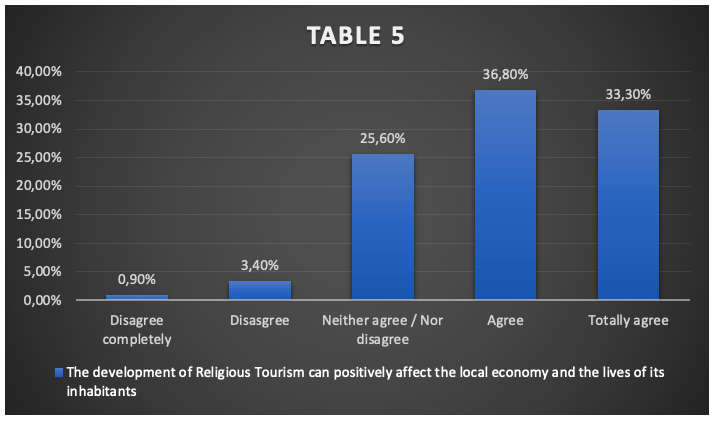
TABLE 5: Positive influence of the local economy and residents’ quality of life from Religious Tourism
The answers of the respondents conclude in a positive assessment of the results obtained from Religious Tourism regarding the growth of the economy and the living conditions of the recipient area. They agree that this type of development can bring positive results, with a mean number of 3.98
Questions c3-c4: « During your visit to a destination you show interest in the religious customs and traditions of the local community » and « During your visit to a destination you show interest in participating in religious festivals and events »
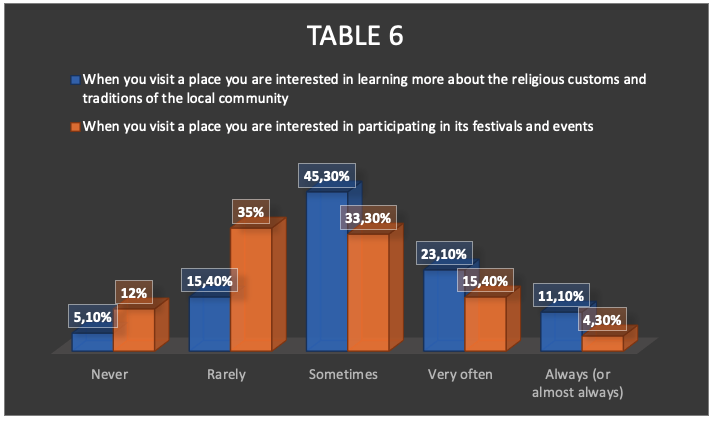
TABLE 6: Interest and participation in religious customs, celebrations, events
As seen in table 6 the majority of respondents, with a percentage of 79,5%, are interested in being informed and learning more about the religious traditions of the place they are visiting. However, the percentage that participates in celebrations and events appears reduced. It makes sense, to an extent, due to the fact that events and festivals usually only take place on certain days within the calendar year. It is difficult for most travelers and of course for the students, who our research sample consists of, to have the free time and the possibility to partake in religious activities that are limited to certain days.
Question c5: « Do you consider faith to be a factor in choosing a tourist destination »
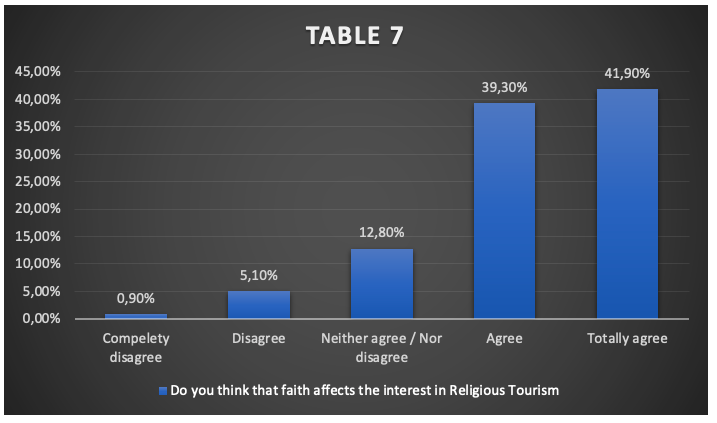
TABLE 7: Faith as an influence factor
In this question, the debate rises, whether they consider faith in religion to be an important factor influencing the interest in participating in trips with religious elements. With a mean number of 4.16, it is believed that religion can positively affect interest
Question c6: « Would you be interested in working in the field of Religious Tourism? »
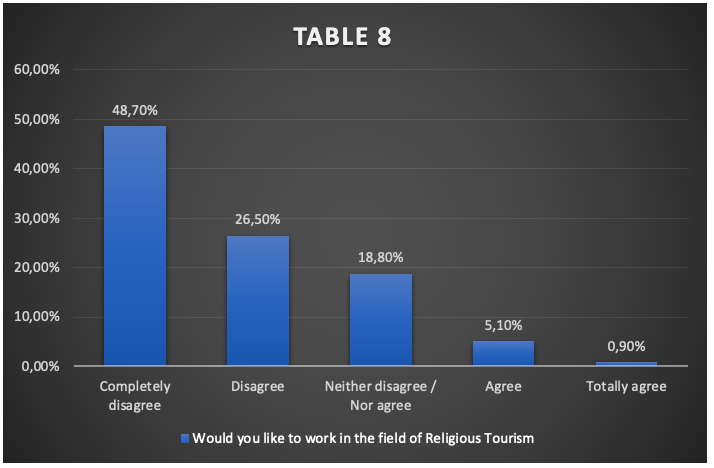
TABLE 8: Employment in the field of Religious Tourism
The answers of the students are of particular interest since, as shown in graph 8, the largest percentage reaching 48,7% does not wish to work in the field of Religious Tourism.
Question c7: « The Greek state shows interest in supporting Religious Tourism by dedicating to support and upgrade it
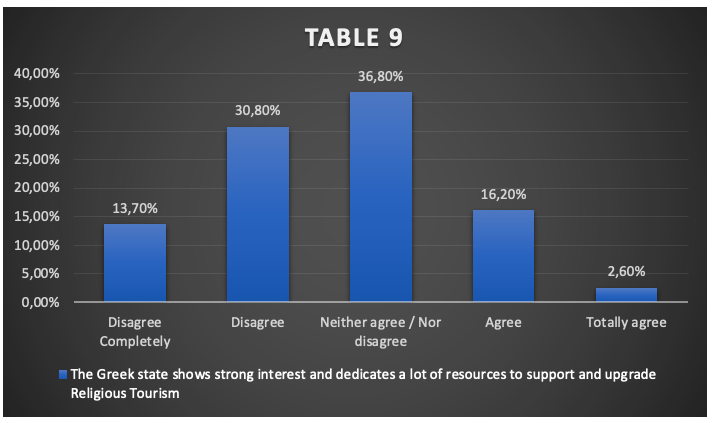
TABLE 9: Interest of the Greek state and support of Religious Tourism
With only 18.8% answering “agree” or “totally agree” the respondents concur that the state does not effectively support the development of Religious Tourism.
Question c10: « In which areas do you think the state should focus in order to develop Religious Tourism in Greece? »
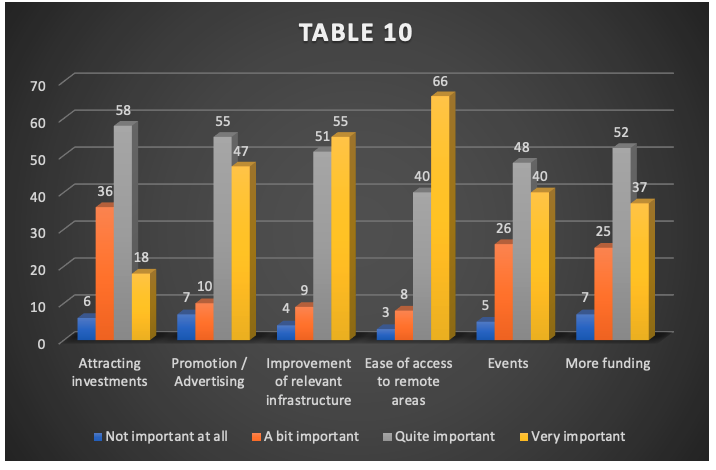
TABLE 10: Areas of focus of the state for the development of Religious Tourism
Important factors that can intensify development are the increase in funding from the state, the attraction of foreign and private investments, the strengthening of advertising and the organization of new and more religious events. It is an interesting fact that the respondents consider it very important to improve infrastructure and facilitate access to monuments located in remote areas. Many religious monuments are located in mountainous areas, where access and transportation is limited, expensive or tedious, especially for elderly people. For this reason, the state must invest in the upgrading of road networks, the installation of lifts for people with special needs, the expansion of public transport networks and the maintenance of monuments.
At the end of the questionnaire, there was an open-ended optional question regarding what steps should be taken to develop the tourism product and the answers converged on: «improving infrastracture», «facilitating access to monuments located in remote areas» and «easier access for the elderly and disabled» as many religious monuments are located in mountainous areas where access and transport is limited, expensive or tiring especially for the elderly or people with limited mobility.
- Conclusions
In succession, the conclusions obtained from the above research are presented.
- At a time when Religious Tourism does not receive the proper promotion and exposure it deserves, it is positive that students wish to participate in such activities.
- As a large percentage of visitors are families the recepient areas should take advantage of this fact by promoting their religious tourism product as family friendly but also by organizing religious events with a social character to attract groups of younger travelers.
- In order to organize a visit to a religious destination, it is necessary for the potential traveler to be well informed as the medium used to obtain information is important. A medium of poor quality such as a website with inaccurate information could create a false or negative image of the destination and its history. Quality means include, among others, religious and historical texts as through them the interested party can learn about the rich history of the monuments, the religious traditions and holy places as well as their importance over time with accuracy (Manola, 2020). Historical texts can also provide a motivation to visit for a reader, as through the texts they can discover monuments and temples that will make them interested in visiting them. (Manola & Trikalitis ,2020).
- Popularity is an interesting reason to promote a tourism product, perhaps because certain monuments receive a lot of publicity and thus a visit to them becomes a topic of discussion on the internet, which covers a feeling of “participation” in the current travel trends. Of the additional motivations that belong to the “Other” category, the respondents mainly answered that all the aforementioned activities are for them an equally strong motivation to visit giving “open-ended” answers such as social media.
- Perhaps the university does not inspire students enough to study more about Religious Tourism because it prioritizes other larger sectors of the tourism industry, still the improvement of the product requires trained staff and executives who can upgrade the policies and invest in the right steps therefore it becomes necessary to cultivate the interest of students in this direction.
- We realize that the cultural promotion of the monuments combined with the appropriate information of the history and condition of the monuments is important to maintain and increase the number of culturally motivated visitors, a category that constitutes the majority of the sample. Equally important is the organization of quality events and the correct ritual of religious festivals in order to maintain the attendance of religious people at the monuments, a category of visitors with significant influence on the local culture of the recipient area.
- The development of religious tourism can bring positive results to the economy of a region, provided that there is appropriate planning by the relevant bodies and respect by the visitors.
- Without proper support from the Greek state, Religious Tourism will not be able to develop. In a competitive market such as tourism, appropriate investments and interest from the state are required.
- A business can easily display advertisements withing websites and promote the price of the trip and its name to its potential customers. It is also important to display the monument so that the advertisement attracts religious people but to represent it with neutrality so as to also attract potential customers who are faithful in other religions (Rejman et al, 2016). There are not a few travelers who wish for example to travel to India in order to admire Taj Mahal while not being Muslim.
- The relevant bodies, such as the EOT, aim to promote the destinations in the visual media in order to create a positive and attractive image. There are many ways to accomplish this goal, such as showcasing the destination on shows, documentaries, digital presentations, advertising campaigns and magazines that will offer useful information and display the beauty of the monuments in order to create a sense of familiarity and trust.
- The state must invest in the improvement of road networks, the installation of lifts for people with special needs, the expansion of public transport networks and the maintenance of the monuments.
Greece is a country that relies on tourism and Religious tourism is a form which despite its immense tradition is considered an unexploited wealth limited to specific places. As the objective is improvement, it should start from the base, from the future professionals of the field who with the appropriate knowledge will be able to chart a path guided by the economic prosperity of the place where the monuments are located but always keeping in mind their protection.
In conclusion, Religious Tourism is a field with enormous potential for our country and an opportunity for diversification with the aim of sustainability and improvement.
REFERENCES
-
Manola, Μ. & Trikalitis, Κ. (2020). “Experiential tour and cultural legacy of 1821. Journey to the offering of the clergy”. Sustainable Development, Culture, Traditions Journal (SDCT-Journal), Volume 1/2020 - Manola, Μ. & Tsatalbassoglou, Α. (2021). “Casual relationships in cases of Russian religions and military perambulations/tourism from 1750-1857”. Sustainable Development, Culture, Traditions Journal (SDCT-Journal) Volume 1/2020
- Manola,M & Teliopoulou,K.(2021). “Cultural routes of Apostle Paul in Greece” Journal of Tourism Research. Volume 26/2021
- Polyzos, S., Niavis, S. (2013), Spatial Analysis of Religious Tourism in Greece, Tourism Today Fall 2013 Full Paper, pp. 81-93
- Rodosthenous, N. (2016), “Worshiping pilgrimage and religious tourism in Greece and Cyprus during ancient times, tourismos: an international multidisciplinary”, JOURNAL OF TOURISM, Volume 11 (Number 2), pp. 120–145
- Rejman, K., Maziarz P., Kwiatkowski C., Haliniarz M. (2016), RELIGIOUS TOURISM AS TOURISM PRODUCT, World Scientific News 57, pp 562-575
- Tala, M. και Padurean, A. (2008) DIMENSIONS OF RELIGIOUS TOURISM, Towards Business Excellence, pp. 242-253
- Terzidou, M., Stylidis, D., Terzidis, K. (2018), “The role of visual media in religious tourists’ destination image, choice, and on-site experience: the case of Tinos, Greece”, Journal of Travel & Tourism Marketing, 35:3, pp. 306-319
- Terzidou, M., Stylidis, D., Szivas, M (2008), “Residents' Perceptions of Religious Tourism and its Socio-Economic Impacts on the Island of Tinos, Tourism and Hospitality Planning & Development, 5:2, pp. 113-129
- Tsatalbasoglou A. (2020) "On the paths of the Iptanesian School" Online Information Day of the Region of the Ionian Islands on the topic "Literature with a tourist guide, “POLYSEMi” - Interreg 2014-2020
- https://conferenceindex.org/conferences/religious-tourism
[1] Religious Tourism Conferences 2023-2025 is an indexed listing of upcoming meetings, seminars, congresses, workshops, programs, more info at htpp://conferenceindex.org/conferences/religious-tourism
